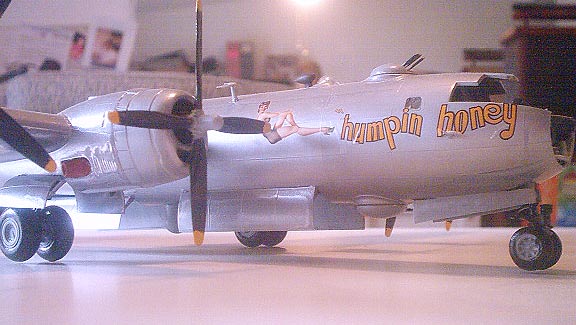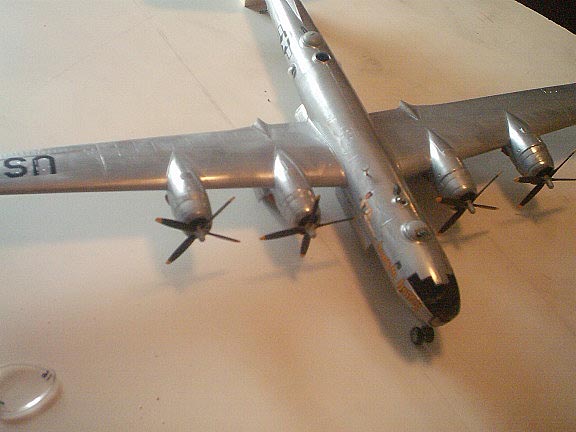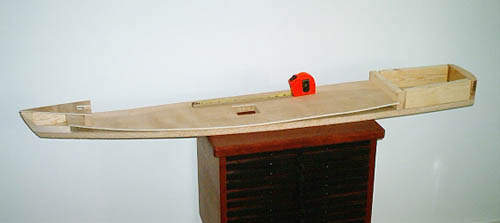Model Ships
The following will be sort of a history lesson. A little of the history you forgot from grammar school -"in 1492 Columbus sailed the ocean blue" and all. But also some maritime history having to do with why various ships were they way they were.
Here is the thing, all these are the same scale. This sort of looses something when all you can see are the pix, but it pleases me. The scale is 1/4" to the foot. Or 1 to 48 if you prefer. In more or less chronological order...
Viking Longship

(Dragon Boat) 9th thru 13th century. Of middling size for its type: 58’ long, 14’ beam, carrying 32 oarsmen. This type of boat was used as ‘amphibious / troop transport’ for long range raiding. It has a shallow -3’ in draft- light weight (perhaps so much so as to be portaged), double ended & nimble, and admirably seaworthy, if Spartan in appointment.
Hanseatic Cog

The ‘cog’ was the major vessel of the northern Europe during the late medieval era –from the 13th to the 17th century. It is interesting that it could be changed from a cargo ship to a man-of-war with the simple addition of’ ‘castles’ at bow and stern. (The front castle gives us the modern word for the front compartment of a vessel, the forecastle -pronounced fōk-səl.)
This model would be 58 feet long, 22 wide, and would draw about seven or eight feet. It would be on the large size among vessels of its type displacing about 90 tons. Much of the Baltic trade was in lumber and these cogs would have been open to allow long logs etc. to be loaded and unloaded easily. This model, however, -with a largely closed hold and would have been be used to transport wax / resin / tar, amber, furs, rye & wheat, honey, salt-fish, wool, linen, and eventually metals and manufactured goods. Arguably, the Hanseatic League brought the Renaissance to Northern Europe.
Arab Dhow
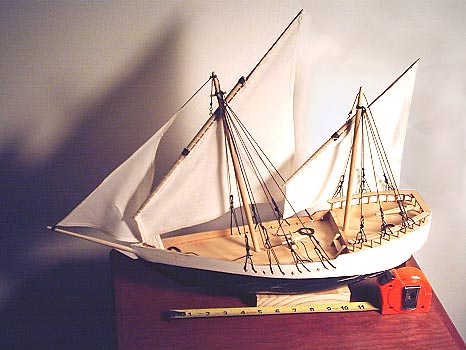
Roughly contemporaneous with the Hanseatic cog, the dhow carried freight and passengers -in miserable conditions- back and forth from the east coast of Africa, north to Persia, and on to India. In the time of Mohamed, they voyaged as far as China to trade in spices, tea, and silk. Closer to home, they fished and/or carried lumber, water, fruit, coffee, & dates. Lots of dates. So much so that the capacity of dhows is measured not in (European) tons, but in its capacity to carry 180 pound sacks of dates.
While dhows have been around for centuries, and are still used today, their history is murky. Arguably, the Arab dhow actually comes from India. They were built without written plans so their physical history comes from western writings as far back Hellenistic Greece, and later, medieval art.
This model would be fairy modern, 66 feet long –on the large size- and carry 60 tons. It would use a crew of 20 to 30.
Ship’s Cutter:

The largest of the boats carried on the deck of a ship in the 18th and early 19th century. The cutter was used in relatively sheltered waters and when load carrying capacity was paramount, such as provisioning from shore. (Double ended long-boats were preferred in heavy seas or as lifeboats.)
This model would be of a large size for its type. It would be 38 feet long and 14 wide and carry as many as 16 oarsmen and two officers.
Discovery (Discoverie):

The smallest of the three ships that brought colonists to Virginia in 1607. The Discovery was left behind with the colonists. In 1611 Captain Henry Hudson used it in his search for the North-West Passage. It was this ship whose crew mutinied and left Hudson adrift -never to be seen again- in what was was to be named Hudson Bay.
All that is know for sure about this ship was that it was owned by the British East India Company, was "70 tonnes burden", was what was known as a "fly boat", and was launched sometime before 1602.
The Golden Hind:
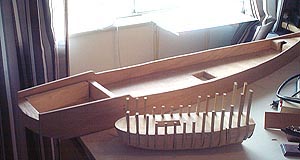
Sir Francis Drake's privateer. Hostory to follow, these pix are just to show the progress.
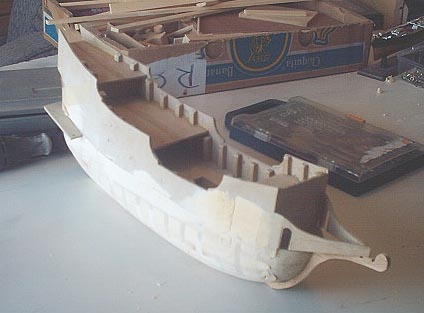
Launch of the HMS Bounty:
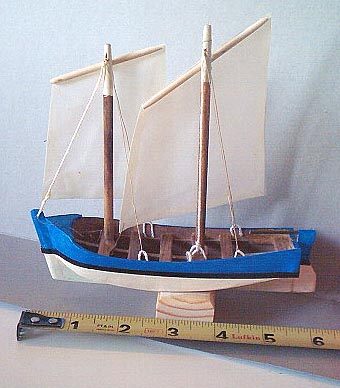
On April 28, 1789 Lieutenant William Bligh and 18 loyal crewmen were set adrift west of Tahiti by Fletcher Christian and 23 mutineers. 47 days and 3618 nautical miles later, all arrived in Dutch Timor.
This launch was 23 feet long and about 6 feet wide. Provisions included ten oars, eight wooden barrels, a chest & anchor, as well as the sails, spars, and rigging.
Clipper Cutty Sark:
The history will have to wait on this famous ship. Instead I will show it as it progresses. At a quarter inch to the foot, the model is (so far) 52" long.
Here we see the deck,(1/4" birch plywood), arched over a good'ol piece of 3/4" particle board. (Cheap and dimensionally stable stuff, particle board.) Pine boards make-up the poop and forecastle.
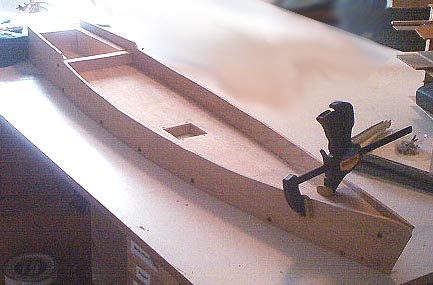
Here she is with her gunwales glued on. Bending wood is all about having lots of places to screw / clamp things together.
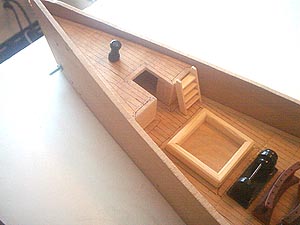
Just for fun -everything comes off for work on the hull to progress- here we have some of the deck stuff.
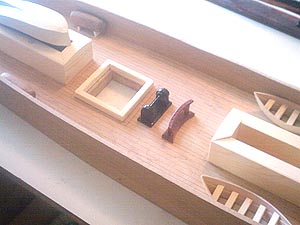
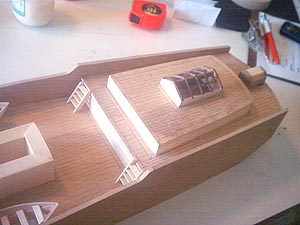
Skipjack:
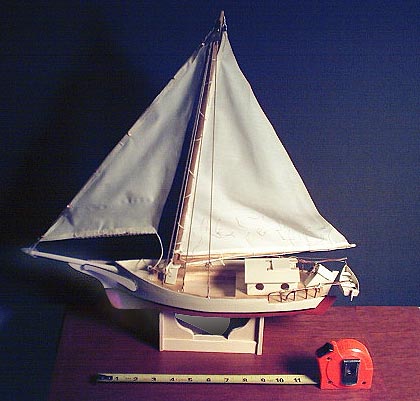
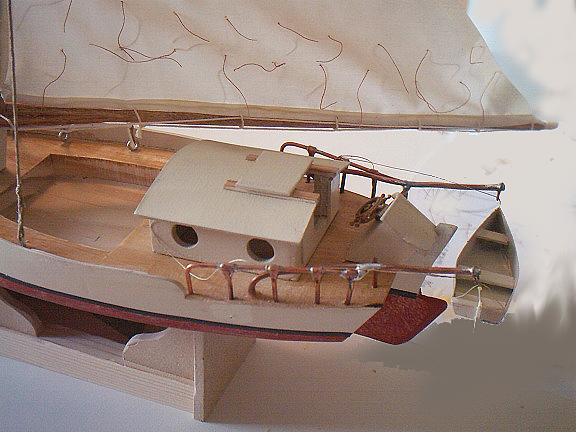
A classic example of form following function, the skipjack evolved to drag one or two large steel basket-like oyster dredges across the bottom of the relatively shallow and sheltered Chesapeake Bay. Note the wide beam, shallow draft, (with the retractable centerboard up), and low mast with an otherwise huge sail plan.
The oyster harvest peaked in 1884, but has declined ever since. The skipjack survived in use till well into the 20th century because of various laws prohibiting engines in oyster dredges and otherwise limiting harvest. These prohibitions were in consequence of the (continuing) declining oyster population in Maryland waters.
This model would be of slightly larger then average size for its type, being 47 feet long and 19 wide. Additionally, it is probably prettier then the work-for-a-living skipjacks of the day.
